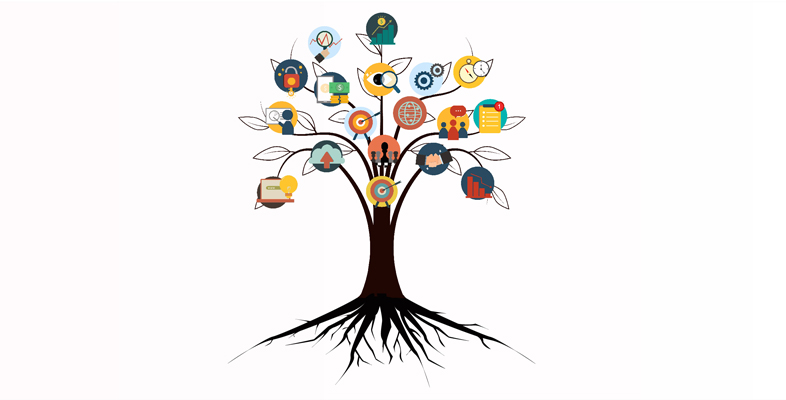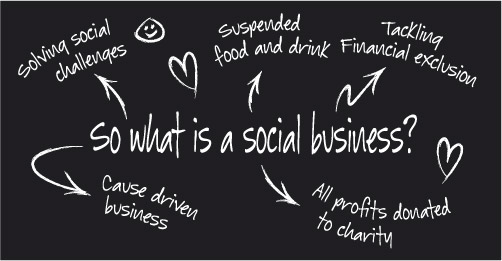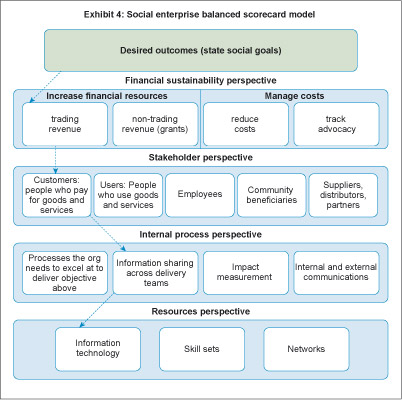Social performance scorecard
The social performance scorecard is another approach to measuring and evaluating the social impact of a sustainable and innovative enterprise. You will now study the social performance scorecard of Social Bite and adapt it for use in evaluating the social impact of an enterprise within your specialist area. Specifically, you are required to complete two steps. First read the Social Bite case study. You will learn that the social performance scorecard and balance scorecard can mean the same thing in terms of both requiring some form of measurements. The Balanced Scorecard is a performance measurement and the aim here is to add the social dimension to this measurement.
Second, complete Activity 11 by applying what you have read in the first step to create your own social performance scorecard.
Social Bite
Social Bite have five cafés in Scotland. All their profit goes towards solving social problems. Social Bite offer ‘suspended coffee and food’. Customers of the cafés can pay in advance for any item of food from the menu and a homeless person can come into the shop to claim it. Each shop currently provides food and hot drinks to over 30 homeless people who visit on a daily basis and get a filling sandwich, hot bowl of soup or a cup of coffee as a direct consequence of these donations. Social Bite also provide employment and try to help people to get off the street and back into society.
The Balanced Scorecard (Kaplan and Norton, 1996) is a performance measurement tool that uses a strategy map to connect an organisation’s day-to-day processes to its organisational goals. Rather than capture how an organisation currently operates, the Balanced Scorecard is concerned with creating a strategy to drive future direction, building in cause and effect linkages while simultaneously taking into account both financial and intangible resources that can determine success or failure. Kaplan and Norton introduced the Balanced Scorecard (BSC) in the early 1990s as a means to provide a more holistic diagnosis of a business’ performance. They argue that lagging financial indicators are not sufficient enough to tell senior management whether work taking place on the ground accurately corresponds to the business’ corporate strategy. Overemphasis on reducing costs in the short run to boost financial indicators underestimates the value of large investments in research and development to the detriment of the company’s long-term survival strategy.
The Balanced Scorecard might add value by making transparent this decision-making framework, capturing both the benefits and consequences to ensure that social enterprise managers make decisions that are strategy-led rather than reactions to short-term conditions in the marketplace. The Balanced Scorecard can be amended for social enterprises. An example of this is the social enterprise (sEL) model.
To amend the original Kaplan and Norton Balanced Scorecard to a sEL model, three changes were introduced: an additional layer was added in which social goals are articulated above the financial perspective; the financial perspective was broadened to focus on sustainability; and the customer perspective was widened to capture a larger number of stakeholder groups.
In the model shown in Figure 6, social enterprises begin by stating their social goals as desired outcomes, and then move into the perspectives. In the financial sustainability perspective, each ‘bubble’ represents an objective. The Social Enterprises Balance Scorecard model appears more complex, and this reflects the hybrid nature of social enterprises that demand more complex management systems. This is best demonstrated through the stakeholder perspective, which has been widened from customers in the original model to distinguishing between those who pay for a service and those who consume it (donors, grant funders, employees and the wider community).
In Figure 6, the arrows illustrate one cause and effect chain from the strategy. For example, Social Bite is a social café. Their goal is to empower the homeless (social goal) through providing quality meals (financial perspective – trading activity). The paying customer (stakeholder perspective) requires that Social Bite demonstrate ‘value for money’. The organisation makes the assumption that the best way to demonstrate this is by reporting impact delivered to the client group (homeless people) across the organisation’s activities (internal process perspective). The best way to resource this is through publicity and organising events and talks (resources perspective).
Activity 11 Creating your own Social Balanced Scorecard
Using a notepad or Excel, create a table in which you propose a social performance scorecard that can be used by an enterprise you are interested in studying. You can use the structure suggested in Figure 6 or you can adapt it as necessary.
Discussion
This activity involved thinking about each of the boxes in the Figure 6. For example, the first box is about desired outcomes and here you can state what type of social goal(s) you are looking to pursue. In the case of the Social Bite case study the goal is ‘to empower the homeless (social goal) through providing quality meals (financial perspective – trading activity)’. You then move to financial sustainability where you can identify what can be done to increase financial resources and manage costs, and so on. Once you have done this for all the components in Figure 6, you will have created your own Social Enterprise Balanced Scorecard model. You can trial this if you own your own enterprise or you can simple select an enterprise of your choice to apply the model.


